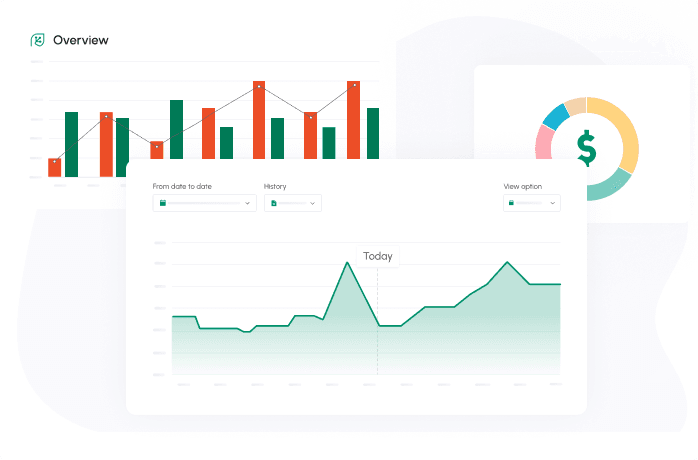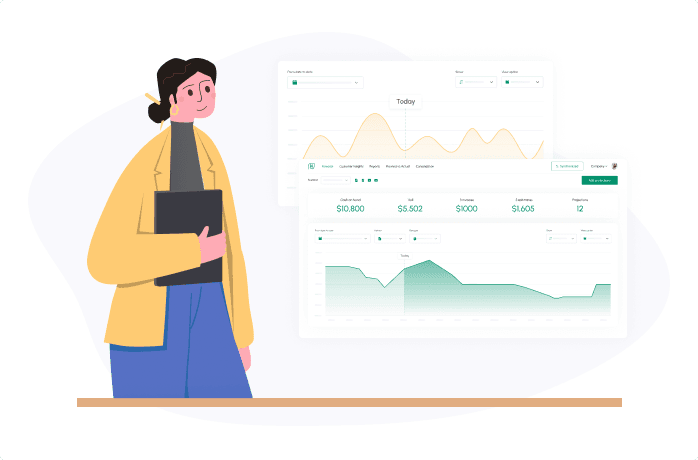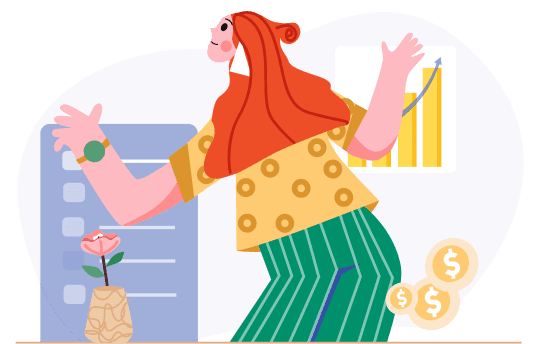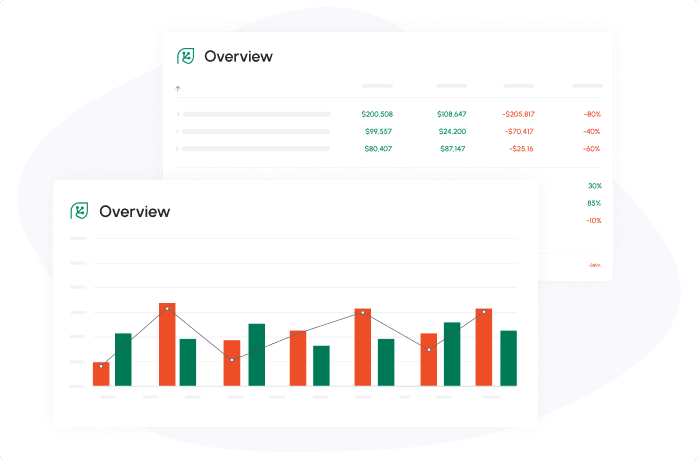

What is the difference between budget and forecast? Too many teams treat them as the same, then get stuck in rigid plans or operate without direction. A financial forecast vs budget comparison shows you when to plan, when to adapt, and how to use both together.
If you’ve ever missed targets or blown your budget, this might be why.
Defining Budgets and Forecasts in Business Context
Why Is a Budget Important and What Is It?
Your yearly plan outlining how your resources will be distributed is called a budget. It serves as your financial guardrails and reflects your business goals for a fixed period.
It’s your financial blueprint, a guide for how to spend money in line with your goals.
Key components of a budget include:
- Projected revenue
- Expected fixed and variable costs
- Planned capital expenditures
- Cash reserve targets and debt repayments
The value of a budget is determined by its ability to:
- Align teams on financial priorities
- Set spending limits across departments
- Establish benchmarks for evaluating success
- Build investor and lender confidence through predictability
Without a well-defined budget, businesses can easily overspend in some areas while neglecting others that are critical to growth.
What Is a Forecast and When Is It Used
A forecast is an adaptable, regularly revised estimate derived from known variables and current trends. It reflects what is likely to happen rather than what you hope will happen.
Forecasting helps leaders to:
- Adjust quickly to shifts in income or costs as they happen
- Monitor operational performance
- Simulate scenarios and test assumptions
- Make informed short-term decisions
For example, if raw material costs spike or customer demand drops unexpectedly, a forecast helps you reallocate resources without waiting for the next budgeting cycle. This adaptability makes forecasting an essential tool for maintaining operational control.
Core Differences Between Budget and Forecast
Understanding the budget vs forecast distinction helps ensure that your planning process supports both vision and flexibility.
Time Frame and Update Frequency
A major difference between budget and forecast lies in how frequently they are updated.
- Budget: Typically created once per fiscal year and rarely modified unless a major strategic change occurs.
- Forecast: Regularly updated on a weekly or monthly basis to account for outside influences and real results.
Forecasts adapt; budgets endure. That’s why pairing both tools allows you to plan long-term while staying responsive.
Many businesses use rolling forecasts to stay flexible—especially those managing growth in volatile markets. A tool that supports frequent updates and scenario modeling makes this much easier to implement in practice.
Role in Strategic vs. Operational Planning
Budgets are strategic; they define annual objectives and big-picture plans. Meanwhile, forecasts focus on your operations, helping teams manage their short-term variables.
Use budgets for:
- Annual goal-setting
- Strategic resource planning
- Investor and board presentations
Use forecasts for:
- Monitoring real-time financial health
- Adjusting plans based on new data
- Identifying short-term threats and opportunities
By separating long-term intentions from short-term realities, businesses gain the insight needed to pivot effectively.
Static Nature of Budgets vs. Dynamic Forecasts
Budgets are static—they provide a benchmark. But in volatile markets, static plans quickly become outdated. That’s where forecasts come in.
Forecasts are dynamic and iterative. Rolling forecasts extend your visibility into future months by continually adding new data. For example, a 90-day rolling forecast allows a company to plan into the next quarter with up-to-date insights, improving confidence in decision-making.

Common Use Cases for Each Tool
Making better, faster judgments results from knowing when to utilize a budget versus a projection.
Budgeting for Annual Financial Targets
Budgets are ideal when organizations need control, predictability, and accountability over a defined time period.
Typical uses for budgets:
- Planning department-level spending
- Setting sales and profit targets
- Managing annual hiring and expansion
- Tracking actuals vs. expectations over time
Example:
A healthcare startup allocates a $600,000 annual marketing budget to drive patient acquisition. Spending is distributed quarterly and benchmarked against expected results.
Forecasting to React to Market Shifts
Frequent changes call for reliable forecasts to guide timely decisions.
Forecasts are especially useful when:
- You experience seasonal or unpredictable demand
- Costs fluctuate due to supply chain or labor shifts
- You need to simulate the outcome of a strategic decision
Example:
A subscription box company notices a Q2 drop in customer signups. The forecast shows you’re likely to fall short on revenue this year. Leadership delays a new hiring round and reinvests in customer retention initiatives, ensuring a more efficient use of capital.
For industries like SaaS or accounting where revenue recognition is tied to monthly cycles, these forecasting adjustments help preserve cash flow and decision-making flexibility.
Combining Budgeting and Forecasting in Practice
In most modern businesses, using both tools in tandem is non-negotiable. Allowing each to fulfill its proper function is crucial.
How to combine effectively:
- Make sure your long-term business objectives are reflected in your annual budget.
- Introduce rolling forecasts to adjust based on actual outcomes.
- Regularly compare your financial forecast vs budget to detect any variance in your performance.
- Act on insights early, adjust plans, shift spending, or re-prioritize investments.
Example:
An e-learning platform projects flat enrollment mid-year, while the budget assumed 20% growth. The forecast triggers a shift in funds from planned events to content development, helping to restore momentum before quarter-end.
This approach supports agility without abandoning accountability.
Benefits of Budgeting in Financial Management
Budgets build a strong foundation for financial management. They offer clarity, control, and long-term perspective.
The top advantages of budgeting include:
- Promotes disciplined resource use
- Sets performance expectations for teams
- Offers measurable KPIs for success
- Assures investors of fiscal responsibility
A strong budget acts as both a compass and a contract—it defines what matters and how resources should be directed toward those outcomes.
Benefits of Forecasting for Dynamic Businesses
Forecasting is a lifeline for navigating uncertainty. For fast-growth businesses, it’s especially powerful.
Why forecasting is critical:
- Provides early warnings for cash flow issues
- Supports agile pricing, hiring, and product decisions
- Helps explore “what-if” scenarios safely
- Aligns leadership around real-time visibility
For startups, knowing the difference between a cash flow forecast and a budget can make or break early financial decisions. Forecasts offer week-by-week insights that can mean the difference between extending the runway and falling short of investor expectations.

Budgeting and Forecasting in Startups vs. Enterprises
The tools may be the same, but startups and large enterprises use these tools differently. Here’s how:
Startups
- Rely on lean cash budget and cash flow forecast models
- Use weekly or biweekly forecasts for maximum agility
- Budget conservatively, aligned with funding milestones
- Adapt frequently to changes in customer behavior or market trends
Enterprises
- Maintain complex, department-specific budgets
- Run formal rolling forecasts quarterly or monthly
- Leverage ERP tools to bring all your data together and maintain consistency.
- Coordinate across finance, operations, and leadership
Regardless of size, mastering the budget vs forecast relationship enables scalable, sustainable growth.
Mistakes to Avoid in Planning Processes
Planning isn’t just about getting numbers on a spreadsheet. It’s about making those numbers meaningful.
Avoid these common pitfalls:
- Confusing a forecast with a budget: One is reactive, the other is proactive.
- *Failing to update forecasts: Outdated inputs lead to poor decisions.
- Neglecting variance analysis: Ignoring forecast vs budget comparisons can hide problems.
- Over-relying on static budgets: Inflexibility reduces competitiveness.
- Ignoring short-term forecasting: Short periods often reveal critical issues you’re not aware of.
Remember, the best plans are those you can actually act on before problems escalate.
Software and Tools for Budgeting and Forecasting
Technology plays a critical role in insightful and efficient financial planning, so finding the right tool is crucial.
Top Pick: Cash Flow Frog
Cash Flow Frog offers robust features designed for small businesses and startups:
- Live cash flow forecast visualization
- Integration with Xero and QuickBooks
- Rolling forecast support and scenario modeling
- Easy-to-use interface with team collaboration
Instead of manually reconciling numbers each month, platforms like this streamline your process so you can focus on decisions, not data entry.
Other Useful Tools:
- QuickBooks Online: Built-in budgeting tools for SMBs
- Float: Great for visualizing cash budget and cash flow forecast in one place
- LivePlan: Combines business planning and forecasting
- Xero: Stands out as a top choice for small business accounting and cash flow forecasting.
Choosing tools? Remember the essential features that can help you maintain a strong financial rhythm: multi-user access, rolling updates, and scenario testing.
Final Thoughts
Understanding the difference between budget vs forecast is your first step to modern business planning. Your budget defines structure, while your forecast drives adaptability. Together, these tools help you develop a financial system that endures and evolves.
If you’re ready to plan with more clarity, more flexibility, and fewer surprises, a smart financial platform like Cash Flow Frog can be the difference between reacting late and planning ahead.

FAQ
Related posts:
You may be interested:
New:












